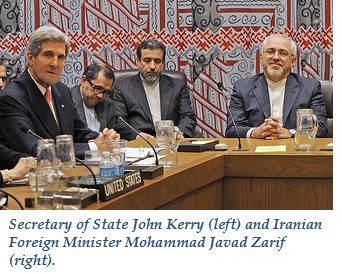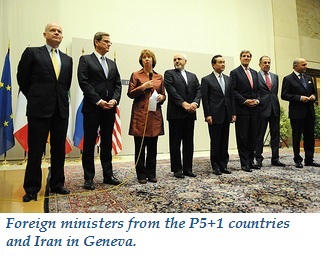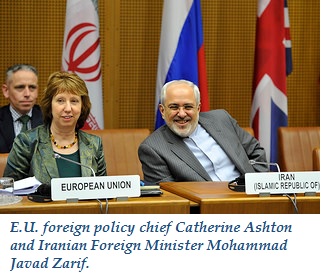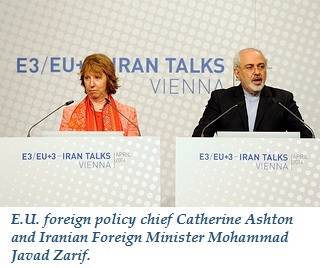The following is a rundown of key events in diplomacy on Iran’s nuclear program since President Hassan Rouhani took office in August 2013.
2013
 Sept. 26 –
Sept. 26 – Foreign ministers from P5+1 countries (Britain, China, France, Germany, Russia and the United States) and Iran met on the sidelines of the U.N. General Assembly and agreed to hold a new round of talks in Geneva.
Sept. 27 – President Barack Obama called Iranian President Hassan Rouhani in what was the first direct communication between a U.S. and Iranian presidents since the 1979 revolution. “The two of us discussed our ongoing efforts to reach an agreement over Iran’s nuclear program,” Obama said at a White House briefing.
Oct. 15-16 – Diplomats from P5+1 countries and Iran met in Geneva to solve the nuclear dispute. They committed to meeting in November to continue talks that were “substantive and forward looking.”
Nov. 7-10 – Iran and the P5+1 made significant headway but ultimately failed to finalize an agreement. Foreign ministers rushed to Geneva as a breakthrough appeared imminent. But last-minute differences, reportedly spurred by French demands for tougher terms, blocked a deal.
Nov. 11 – IAEA Director General Yukiya Amano visited Tehran. He and Iran’s chief of the Atomic Energy Organization, Ali Akbar Salehi, signed a Framework for Cooperation Agreement committing Tehran to take practical steps towards transparency within three months.
 Nov. 24 –
Nov. 24 – Iran and the P5+1 reached an interim agreement that would significantly constrain Tehran’s nuclear program for six months in exchange for modest sanctions relief. Iran pledged to neutralize its stockpile of near-20 percent enriched uranium, halt enrichment above five percent and stop installing centrifuges. Tehran also committed to halt construction of the Arak heavy water reactor.
Dec. 11 – Iran and the IAEA met in Vienna to review the status of the six actions Iran committed to in November as part of the Framework for Cooperation Agreement.
2014
Jan. 9-12 – The P5+1 and Iran met in Geneva and reach an agreement on implementation. The delegations returned to their capitals for approval. On January 12, the parties announced that the Joint Plan of Action will be implemented starting on January 20.
Jan. 20 – The Joint Plan of Action entered into force. The IAEA also issued a report stating that Iran is complying with the deal after reducing their 20% enrichment stockpile and halting work on the Arak heavy water reactor. The United States and European Union announced they have taken steps to waive certain sanctions and release a schedule for releasing Iran’s oil money frozen in other countries.
 Feb.18-20 –
Feb.18-20 – The P5+1 and Iran agreed on a framework for final negotiations on February 20 after three days of discussion in Geneva.
March 3 – IAEA chief Yukiya Amano announced that Iran has implemented the six measures contained in the Framework for Cooperation Agreement but also notes that “much remains to be done to resolve all outstanding issues.”
March 19 – The P5+1 and Iran held another round of closed-door talks on a final nuclear agreement. Ashton and Zarif described their discussions on the Arak heavy water reactor and Western sanctions as “substantive and useful.”
March 20 – The IAEA released a report detailing Iran’s implementation of the interim nuclear deal brokered in November 2013. The report noted that Tehran has not enriched any more uranium to 20 percent. But it had not yet completed a facility to convert low-enriched uranium gas into an oxide, which would need to be reprocessed to fuel a weapon.
 April 7-9 –
April 7-9 – The P5+1 and Iran met in Vienna to continue negotiations on a final nuclear agreement. Iranian Foreign Minister Mohammad Javad Zarif and E.U. foreign policy chief Catherine Ashton reported that they had “substantive and detailed discussions” on all relevant issues.
April 17 – The U.S. State Department announced that Washington had taken steps to release $450 million installment of frozen Iranian funds after the IAEA verified Tehran is complying with the interim nuclear agreement.
May 13-16 – The P5+1 and Iran meet in Vienna to begin drafting a final agreement. The talks end without any tangible progress. But both sides commit to another round of talks in June.
June 9-10 – U.S. Deputy Secretary of State William Burns lead a team of officials to Geneva for bilateral talks with Iran to prepare for the next round of P5+1 talks.
June 16-20 – The P5+1 met in Geneva and produced an outline of a draft agreement but did not make much progress on the core issue of uranium enrichment. They agreed to meet on July 2 and hold continuous talks until the July 20 expiration date.
July 3-19 – The P5+1 began marathon talks on July 3, less than three weeks form the due date for a deal. After about a week and half of discussions, some foreign ministers, including Kerry, Zarif and Hague, went to Vienna to check on progress of the talks. On June 19, the two sides announced that the will extend the talks through November 24, eactly one year since the interim agreement was brokered. Iran agreed to take further steps to decrease its 20 percent enriched uranium stockpile. In return, the P5+1 nations agreed to repatriate $2.8 billion in frozen funds back to Iran.
July 14 Update: Iran released the most detailed report to date explaining its practical needs for its nuclear program. It was posted on the quasi-official website NuclearEnergy.ir.
Sept. 18-26 – Iran and the P5+1 resumed talks on the sidelines of the U.N. General Assembly in New York. Several meetings were held, including a one-on-one meeting between Kerry and Zarif, in which they also discussed the threat posed by the Islamic State in Iraq and Syria. The sides did not reach an understanding on major issues such as uranium enrichment and sanctions relief.
Oct. 14-16 – The P5+1 and Iran met in Vienna made a little progress. But disagreements over Tehran’s uranium enrichment capabilities and a timeline for implementing a deal remained. Officials emphasized that the sides had not given up on the November 24 due-date for a deal and that the talks focused on a “full agreement,” not just understandings of key issues.
Nov. 9-11 -- Kerry, Zarif, and Ashton met for two days of trilateral talks in Oman, followed by a day of meetings between Iran and the full P5+1. The removal of sanctions and levels of uranium enrichment were among the issues on the table, but officials did not report any significant progress from this round of discussions.
Photo Credits: EU External Action Service and U.S. State Department via Flickr
 Sept. 26 – Foreign ministers from P5+1 countries (Britain, China, France, Germany, Russia and the United States) and Iran met on the sidelines of the U.N. General Assembly and agreed to hold a new round of talks in Geneva.
Sept. 26 – Foreign ministers from P5+1 countries (Britain, China, France, Germany, Russia and the United States) and Iran met on the sidelines of the U.N. General Assembly and agreed to hold a new round of talks in Geneva. Nov. 24 – Iran and the P5+1 reached an interim agreement that would significantly constrain Tehran’s nuclear program for six months in exchange for modest sanctions relief. Iran pledged to neutralize its stockpile of near-20 percent enriched uranium, halt enrichment above five percent and stop installing centrifuges. Tehran also committed to halt construction of the Arak heavy water reactor.
Nov. 24 – Iran and the P5+1 reached an interim agreement that would significantly constrain Tehran’s nuclear program for six months in exchange for modest sanctions relief. Iran pledged to neutralize its stockpile of near-20 percent enriched uranium, halt enrichment above five percent and stop installing centrifuges. Tehran also committed to halt construction of the Arak heavy water reactor. Feb.18-20 – The P5+1 and Iran agreed on a framework for final negotiations on February 20 after three days of discussion in Geneva.
Feb.18-20 – The P5+1 and Iran agreed on a framework for final negotiations on February 20 after three days of discussion in Geneva.  April 7-9 – The P5+1 and Iran met in Vienna to continue negotiations on a final nuclear agreement. Iranian Foreign Minister Mohammad Javad Zarif and E.U. foreign policy chief Catherine Ashton reported that they had “substantive and detailed discussions” on all relevant issues.
April 7-9 – The P5+1 and Iran met in Vienna to continue negotiations on a final nuclear agreement. Iranian Foreign Minister Mohammad Javad Zarif and E.U. foreign policy chief Catherine Ashton reported that they had “substantive and detailed discussions” on all relevant issues.